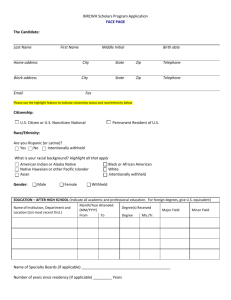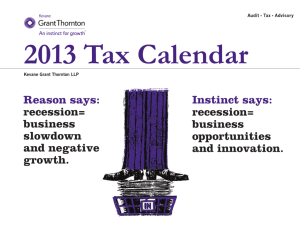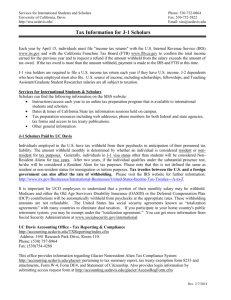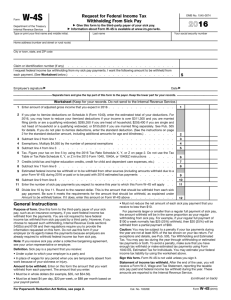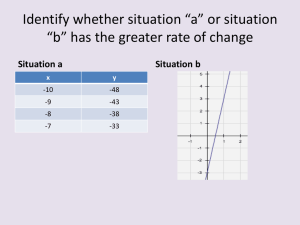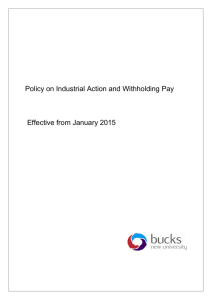A Modern Business Model for Government
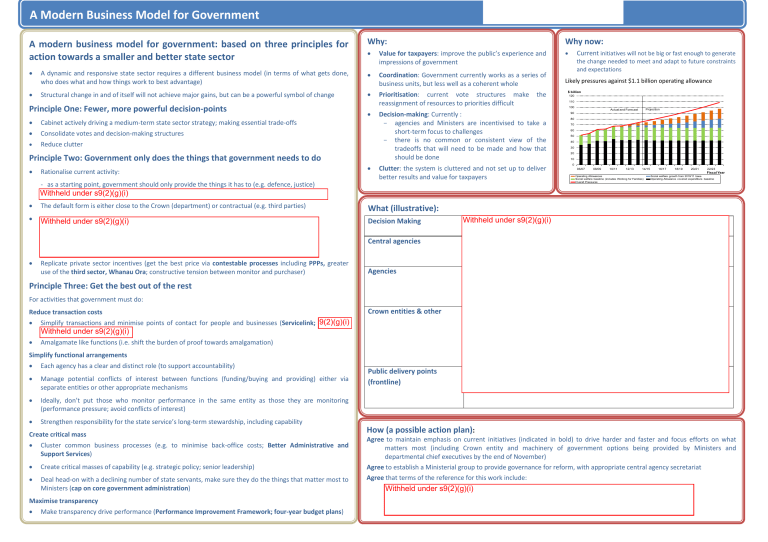
A Modern Business Model for Government
A modern business model for government: based on three principles for action towards a smaller and better state sector
• A dynamic and responsive state sector requires a different business model (in terms of what gets done, who does what and how things work to best advantage)
• Structural change in and of itself will not achieve major gains, but can be a powerful symbol of change
Principle One: Fewer, more powerful decision-points
• Cabinet actively driving a medium-term state sector strategy; making essential trade-offs
• Consolidate votes and decision-making structures
• Reduce clutter
Principle Two: Government only does the things that government needs to do
• Rationalise current activity:
as a starting point, government should only provide the things it has to (e.g. defence, justice)
Withheld under s9(2)(g)(i)
• The default form is either close to the Crown (department) or contractual (e.g. third parties)
•
Withheld under s9(2)(g)(i)
• Replicate private sector incentives (get the best price via contestable processes including PPPs, greater use of the third sector, Whanau Ora ; constructive tension between monitor and purchaser)
Principle Three: Get the best out of the rest
For activities that government must do:
Reduce transaction costs
• Simplify transactions and minimise points of contact for people and businesses ( Servicelink; 9(2)(g)(i)
Withheld under s9(2)(g)(i)
• Amalgamate like functions (i.e. shift the burden of proof towards amalgamation)
Simplify functional arrangements
• Each agency has a clear and distinct role (to support accountability)
• Manage potential conflicts of interest between functions (funding/buying and providing) either via separate entities or other appropriate mechanisms
• Ideally, don’t put those who monitor performance in the same entity as those they are monitoring
(performance pressure; avoid conflicts of interest)
• Strengthen responsibility for the state service’s long-term stewardship, including capability
Create critical mass
• Cluster common business processes (e.g. to minimise back-office costs; Better Administrative and
Support Services )
• Create critical masses of capability (e.g. strategic policy; senior leadership)
• Deal head-on with a declining number of state servants, make sure they do the things that matter most to
Ministers ( cap on core government administration )
Maximise transparency
• Make transparency drive performance ( Performance Improvement Framework; four-year budget plans )
Why:
• Value for taxpayers : improve the public’s experience and impressions of government
• Coordination : Government currently works as a series of business units, but less well as a coherent whole
• Prioritisation : current vote structures make the reassignment of resources to priorities difficult
• Decision-making : Currently :
agencies and Ministers are incentivised to take a short-term focus to challenges
there is no common or consistent view of the tradeoffs that will need to be made and how that should be done
• Clutter : the system is cluttered and not set up to deliver better results and value for taxpayers
What (illustrative):
Decision Making
Central agencies
Agencies
Crown entities & other
Public delivery points
(frontline)
-
-
-
-
-
-
-
-
Why now:
• Current initiatives will not be big or fast enough to generate the change needed to meet and adapt to future constraints and expectations
Likely pressures against $1.1 billion operating allowance
$ billion
120
110
100
90
80
70
60
50
40
30
20
10
Actual and Forecast Projection
0
06/07 08/09 10/11 12/13
Operating Allowances
Social welfare baseline (includes Working for Families)
Overall Pressures
14/15 16/17 18/19 20/21 22/23
Social welfare growth from 2010/11 base
Fiscal Year
Operating Allowance covered expenditure baseline
How (a possible action plan)
:
Agree to maintain emphasis on current initiatives (indicated in bold) to drive harder and faster and focus efforts on what matters most (including Crown entity and machinery of government options being provided by Ministers and departmental chief executives by the end of November)
Agree to establish a Ministerial group to provide governance for reform, with appropriate central agency secretariat
Agree that terms of the reference for this work include:

